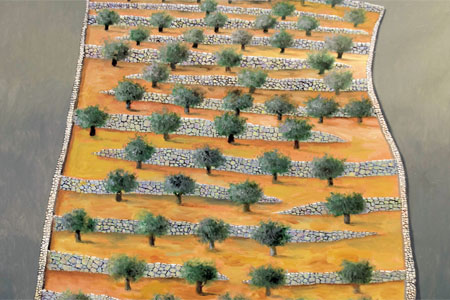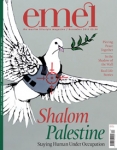
Art under Occupation
Issue 87 December 2011
Throughout history, art has always been the voice of freedom under oppression. It is also a tool to celebrate the richness and diversity of people and culture. Fatema Zehra meets two of Palestine’s most prominent artists, Sliman Mansour and Nabil Anani.
Silman Mansour
Suleiman (aka Sliman) Mansour was born in Birzeit in 1947. He has been a pivotal cultural leader for more than 40 years. Mansour played a big role in establishing the Palestinian art movement in the illegally Occupied Territories. He was head of the Artists Union during the first Intifada, co-founder (and now director) of the Wasiti Art Center in Jerusalem, and also a member of the New Vision artist group, which focuses on the use of local material in artwork. His work has played an empowering role within Palestinian society, reflecting their identity and offering hope and inspiration through the realms of visual art. Not only does his work promote creativity and self-expression, it also offers a humanistic and non-violent option for resisting the Occupation, as well as providing a sense of pride and appreciation of Palestinian cultural heritage and tradition.

Mansour utilises his art to express the living stories of the conflict beyond the present. He has lived through a changing history, experiencing numerous conditions. Perhaps it is this adaptability that has allowed him to effectively reflect the story of his people, expressing their hopes and fears as well as representing their cultural strength.
Mansour’s work “imagines how life would be without the Occupation.” He recounts the long years under the Occupation, noting that “several generations have been born under the Occupation and for them that has become a normal way of life.” Mansour aims to “portray the absurdity and the cruelty of the Occupation.” He hopes to reaffirm and strengthen the connection that the Palestinians have to their land and their roots, by recreating lost connections through art.
As a Palestinian Christian, Mansour feels that Islam is not only part of his culture but also his identity. It is manifested morally by his “search for justice, equality and freedom,” and visually by using many Islamic ornaments, Arabic calligraphy and Qur’anic verses in his art.
At the beginning of the first Intifada in 1987, Mansour started working with mud and earth, feeling that this medium was close to his heart. Alongside this, many of Mansour’s exhibition pieces work with pencil and charcoal. His work focuses on the world we live in, therefore in order to prepare himself he reads everything from the daily news to history books and literature. The main challenge is converting these ideas into visible artistic forms. “For me, this is the hardest phase of a piece, the conception of the idea; it involves multiple sketches and some space to experiment both in colour and form.”
Art is an important tool for the Palestinians; it helps “maintain a revival of Palestinian identity,” creating symbols of resistance against the occupiers, whilst also celebrating Palestinian heritage through imagery of the land, people and customs. Recent years have seen a surge in artists from the Occupied Territories, exploring different concepts of their situation, and how it affects their everyday lives. Art has become a tool to explore and vent anger, whilst also making a statement to all who come in contact with it.
As with most artists, Mansour would say all his works “are like my children”, and could not choose between them. But when probed further, he states, “it is the painting that I haven’t started yet. It is entitled Jerusalem is Liberated.”
Nabil Anani
Nabil Anani held his first exhibition in Jerusalem in 1972. Considered to be one of the most prominent Palestinian artists working today, he graduated in Fine Arts from Alexandria University in Egypt, and then returned to his native Palestine. In addition to authoring a number of art books, he was a founding member of the New Vision artist group and of the Jerusalem Wasiti Art Center in 1994. On retiring from his teaching post in 2003, Anani has dedicate much time to the arena of arts, playing a key role in the establishment of the first International Academy of Fine Arts in Palestine. Since his first exhibition, Anani has participated in shows all over the world, from New York to Tokyo.
Anani works with a multitude of mediums, producing paintings, ceramic pieces and sculptures. He pioneered the use of local materials, such as leather, wood and copper believing it to reaffirm the strength of the land. Art materials often need to be purchased from Israeli sources as materials are restricted and often not readily available within Palestine. Much of his current work focuses on the Palestinian landscape, “especially the olive tree orchards, which stretch out on the hills throughout the West Bank, as a symbol of the fact that the Palestinians are rooted deeply in their land.” Anani hopes to “portray the right of the people to exist, and to have their own independent state,” a recurring message of many of the artists that originate and work in the Occupied Territories.
Anani’s recent work uses acrylic with a wax technique that involves scraping the wax away to reveal different layers of colours. His partiality for experimenting with mediums is apparent, having “previously used goat’s leather as a canvas, and using dyes and henna amongst other materials.” His latest works project a strong theme of the olive tree, with the tree being a profoundly embedded reminder of the Palestinian’s culture, “some of the trees were planted in Roman times.” Furthermore, there is a deep-rooted dependency on the olive tree with it being a major source of income as well as a vital ingredient for everyday consumption. Anani stresses the importance of the tree to his work, as it is “subject to brutal attacks by Israeli settlers, who think that burning and uprooting olive trees is equal to uprooting Palestinians from their land.” But he stands defiant, proclaiming that “the existence of olive trees in our landscape reflects our identity as Palestinians.”
Anani remarks on the importance of the Islamic influence through it being integral to society, and its emphasis on the importance of human life and justice. Furthermore, he notes the direct impact his fondness of Islamic art and styles have had on his work. A strong faith that “one day Palestinians will be rid of the Occupation and will have our own independent state,” acts as inspiration to Anani’s works. This is the passion that drives him to create pieces that take anything from one week to twenty days to complete. A strong motivation to recreate the struggles and message of his people in a visible artistic form, paired with the mood of his studio with several sketches, Anani allows the medium of his work to talk. His art is a reminder that regardless of the vision or method of artistic expression, the experience and living memory of Palestine and what it means to be Palestinian is ever-present. These expressions of identity, and messages of frustration and hope give voices to a conflict that is often turned into a game of numbers, or worse, not represented fairly to the international community.
Bookmark this |
|
Add to DIGG |
|
Add to del.icio.us |
|
Stumble this |
|
Share on Facebook |
|
Share this |
|
Send to a Friend |
|
Link to this |
|
Printer Friendly |
|
Print in plain text |
|


Comments
0 Comments